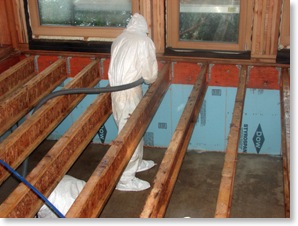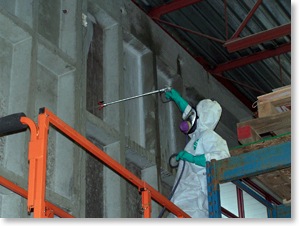Is your home or office building contaminated with mould?
Often, the first sign of mould is a musty smell in a basement or crawl space. Sometimes there is visible staining on a wall or ceiling. In some cases, there is little or no evidence that mould is growing inside your home.
If you have experienced any one of these events in your home, you might consider having a professional investigation done to determine if mould is the problem
- A recent flood - even after professional drying and cleaning mould can become established and continues to grow long after the flooding event
- Stains on the walls or ceiling - especially in a condo or townhouse - you may not know if your neighbour has had water or plumbing problems
- A slow or chronic plumbing leak - a small amount of water over a few days can be enough to trigger mould to grow
- Heavy condensation on your windows - could be evidence of high relative humidity - this can cause mould to grow
- Musty odours - stronger at times - sometimes barely noticable
- Respiratory or sinus problems - but you feel better a few hours after you leave the house or office
Before anyone can give you advice on a mould problem, the severity of the problem has to be established.
The first thing that needs to be determined is if the suspected issue is a mould problem or something else. As a homeowner you don't want to be put into the position of paying for expensive remediation or removal, if it is not required.
The problem with mould is that it can cause a number of serious problems for a property owner:
- Mould can cause allergic reactions and health problems for the inhabitants of a building.
- Mould can make even a prime property difficult to sell.
- It can devalue your property's potential sales worth.
- It can, in a short period of time, cause cosmetic damage to a building and
- Over a longer time, cause structural damage to a building.
We have the experience to guide you through the process from the inspection to the remediation and final certification.
What steps need to be taken if mould is found in your home ...
1. Mould Inspections and Air Sampling
2. Remediation or Mould Removal
3. Post-remediation certification
______________________________________________________________________________________
Mould Inspection and Mould Testing in the Greater Vancouver Area
- On-Site Testing, with Microscopy
- Moisture Survey of the building
- Full consultation services
- Detailed, written scope of work provided
- Individual advice and remediation recommendations
- Detailed, easy to understand explanations of the remediation required
- Written quotations for remediation included.
- Inspections for tenants
More information on the mould inspection, air sampling - what the inspection includes, pricing
______________________________________________________________________________________
Prefer to Do- It -Yourself ?
Some mould remediation tips
We advocate the EPA recommendations that individuals untrained in bio-containment abatement procedures do not attempt to perform remediation on moulds with an aggregate area of contamination of 10 square feet or more (regardless of the type), or on those moulds, (regardless of area), which are considered to be toxic or pathogens.
More info on DIY mould remediation for small projects....
Eco-Impact and Mould Experts
Call Lynn or Ryan for advice or to make a booking for an inspection
Telephone: (778) 786-1552 or (604) 628-7224
Office hours: Monday to Friday 9AM - 7PM



